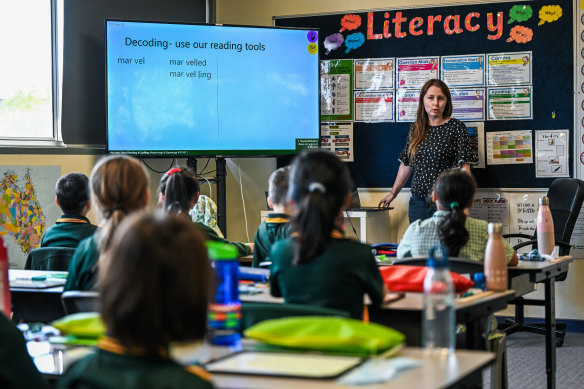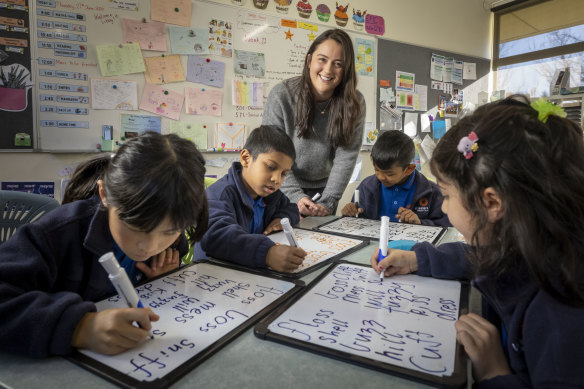By Bridie Smith
The results of a switch to mandated phonics in public schools are unlikely to show themselves for two to three years, with patience and parental backing the keys to success.
New research says schools have a greater chance of achieving positive results when introducing new programs, including phonics as a way of teaching students to read, if they garner support from parents and invest in teacher training.

Teacher Krystal Rickerby with students at Brandon Park Primary School. Changing the way students are taught to read is one of the biggest challenges schools face. Credit: Joe Armao
The study, by the Australian Education Research Organisation and the Murdoch Children’s Research Institute, also found that schools which acknowledged that improving results such as NAPLAN occurred over a long timeframe were more likely to implement changes successfully.
One of the most significant changes currently facing schools was announced in June, when Victorian Education Minister Ben Carroll said all state schools would be required to teach structured phonics from next year as part of an explicit teaching approach.
Systematic synthetic phonics teaches children the sounds of the English language and the letter combinations that make them. It is different to balanced literacy, which includes some phonics, but also uses strategies to guess words based on pictures and context.
The direction announced in June means prep to grade 2 students will receive a minimum of 25 minutes of daily explicit teaching of phonics and phonemic awareness.

Structured language specialist Maddy Gallagher teaches phonics at Wheelers Hill Primary School.Credit: Wayne Taylor
Schools which have not moved towards explicit teaching of phonics by next year will need to show planning for the change over the next three years.
Professor Sharon Goldfeld from the Murdoch Children’s Research Institute said the policy shift would be significant for schools.
“I think this is probably one of the biggest system change issues,” Goldfeld said. “However, the level of difficulty will depend on the school leadership and its openness to do these sorts of things.”
The Murdoch institute’s Getting it Right from the Start project involved 16 government and Catholic schools which had reported poor results in oral language and literacy among grade 2 students.
The research, to be released on Tuesday, found the greater a school’s readiness for change, the better a program was implemented. But Goldfeld said how well resourced a school was and its ability to work towards longer timeframes also played a part.
“It takes two to three years for a school to get up to speed. That’s the kind of time period you really need to give yourself, there’s no magic wand,” she said.
While the introduction of structured phonics from next year would likely be evident in prep to grade 2 classrooms, Goldfeld said schools would not see that improvement documented until those students completed their first NAPLAN assessment in grade 3.
Dr Jenny Donovan from the Australian Education Research Organisation said the research results underscored the need for schools to have systems in place which gave staff and the school community clarity, time and resources.
“Using evidence-based practices such as explicit teaching of phonics in reading instruction is obviously very important, but implementation of change is complex and must be undertaken carefully to ensure success,” she said.
Donovan said it was important schools limited the number of changes it made to a manageable level.
“If, like in Victoria where [the government] has said, ‘We’re going to focus on everybody moving to a synthetic teaching approach to the teaching of reading and an explicit teaching approach in general’, that’s one very big change.
“What you wouldn’t want to do at the same time is decide that you’re going to install a new technology system.”
Start the day with a summary of the day’s most important and interesting stories, analysis and insights. Sign up for our Morning Edition newsletter.